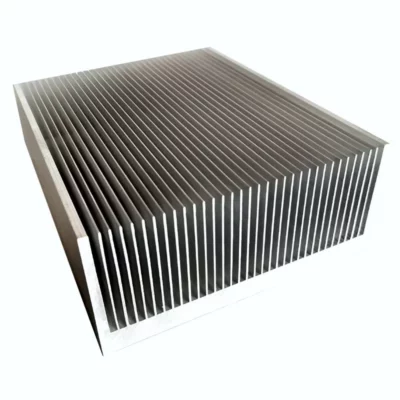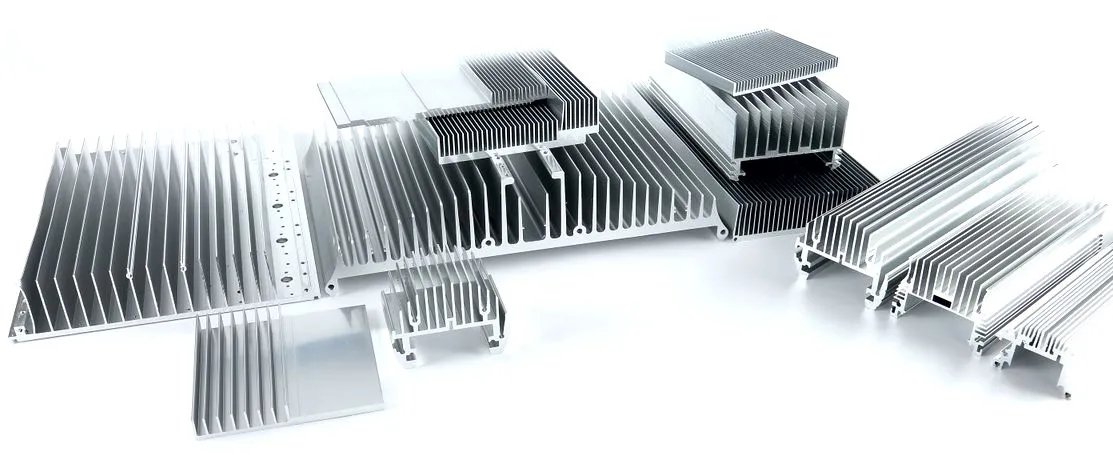Milling Customized Extruded Aluminum Heatsinks: Precision Manufacturing for Efficient Heat Dissipation
CNC machining aluminum extruded heatsinks is a commonly used manufacturing method in the electronics industry. Heatsinks are used to dissipate heat from electronic components, such as CPUs, GPUs, and power supplies, to prevent overheating and damage to the components. Aluminum is a popular material for heatsinks due to its excellent thermal conductivity, lightweight, and corrosion resistance. This article will discuss the benefits of aluminum for the production of heatsinks and the benefits of aluminum extrusion for manufacturing heatsinks.

Benefits of Aluminum for Production of Heatsinks
Excellent Thermal Conductivity
The primary benefit of aluminum for the production of heatsinks is its high thermal conductivity. Thermal conductivity is the measure of a material’s ability to transfer heat. Aluminum has a thermal conductivity of approximately 205 W/mK, which is higher than other common metals used for heatsinks, such as copper and steel. This high thermal conductivity means that aluminum can quickly transfer heat away from the electronic components and dissipate it into the environment.
Aluminum is a Lightweight Material
Another benefit of aluminum for the production of heatsinks is its lightweight. Aluminum has a density of approximately 2.7 g/cm3, which is lower than other common metals used for heatsinks, such as copper and steel. This lower density means that aluminum heatsinks are lighter and more suitable for portable electronic devices, such as laptops and smartphones.
Good Corrosion Resistance
Aluminum is also highly resistant to corrosion, which is a significant advantage in electronic devices that generate heat and are susceptible to damage from moisture and other environmental factors. The natural oxide layer that forms on the surface of aluminum protects it from corrosion, making it an ideal material for heatsinks in harsh environments.

Benefits of Aluminum Extrusion for Manufacturing Heatsinks
Aluminum extrusion is a popular method for the manufacture of heatsinks because it allows for the creation of complex shapes and designs that would be difficult or impossible to achieve through other manufacturing methods. Aluminum extrusion involves forcing a heated aluminum billet through a shaped die, creating a continuous profile of the desired shape. The profile is then cut to the desired length, and any necessary machining is carried out to create the final heatsink.
Extrusion is a Cost-Effective Solution
One of the benefits of aluminum extrusion for manufacturing heatsinks is that it is cost-effective. The extrusion process is a highly efficient and economical method of producing large quantities of heatsinks with consistent quality. The process can be automated, reducing labor costs and increasing production rates. Additionally, the use of aluminum as a material for heatsinks is cost-effective due to its availability and lower cost compared to other materials, such as copper.
Design Flexibility of Aluminum Extrusions
Aluminum extrusion provides the benefit of creating heatsinks with a high degree of design flexibility. The extrusion process allows for the production of heatsinks with intricate designs and features, such as fins and grooves, to increase surface area and improve heat dissipation. The use of CNC machining allows for even greater design flexibility, enabling the creation of complex heatsinks with precise dimensions and features.
Consistent Quality of the Extrusion Process
The extrusion process ensures that each heatsink is of uniform thickness and has consistent thermal conductivity throughout its entire length. This consistency is essential for effective heat dissipation and preventing damage to electronic components. Additionally, the use of CNC machining allows for the creation of heatsinks with tight tolerances and a high degree of accuracy, ensuring consistent quality across all heatsinks produced.
Environmentally Friendly Manufacturing process
Aluminum extrusion is an environmentally friendly manufacturing process. Aluminum is a highly recyclable material, and the extrusion process produces minimal waste. Any scraps or offcuts from the extrusion process can be melted down and reused, reducing the amount of waste generated in the production process.
Milling Customized Aluminum Heatsinks
Customized extruded aluminum heatsinks are a popular choice for many electronic applications that require efficient heat dissipation. These heatsinks are designed to be lightweight, durable, and easy to manufacture, making them a popular choice for a wide range of industries, including aerospace, automotive, and consumer electronics.
At our manufacturing facility, we specialize in producing high-quality, customized extruded aluminum heatsinks that meet the specific needs of our customers. We use state-of-the-art equipment and advanced manufacturing techniques to ensure that each heatsink we produce is of the highest quality.
One of the key steps in manufacturing customized extruded aluminum heatsinks is the milling process. Milling is a machining process that involves using a cutting tool to remove material from a workpiece, creating a desired shape or surface. In the case of heatsinks, milling is used to create fins and other features that help to dissipate heat more efficiently.
To begin the milling process, we start by selecting the appropriate aluminum extrusion profile based on the specifications provided by the customer. We then use a CNC milling machine to cut the profile into the desired shape and size, using specialized cutting tools that are designed to produce precise and accurate cuts.
During the milling process, our technicians carefully monitor the cutting process to ensure that each heatsink is milled to the exact specifications provided by the customer. This involves making adjustments to the milling machine as needed to ensure that the fins and other features are created to the correct depth, width, and spacing.
Once the milling process is complete, the heatsinks are inspected and tested to ensure that they meet our strict quality standards. This includes checking for any defects, such as rough edges or irregularities in the fins, and verifying that the heatsinks are within the specified tolerances for dimensions and surface finish.
Conclusion
In conclusion, CNC machining aluminum extruded heatsinks is a common and effective method of manufacturing heatsinks for electronic devices. The benefits of aluminum as a material for heatsinks include its high thermal conductivity, lightweight, and corrosion resistance. The benefits of aluminum extrusion for manufacturing heatsinks include cost-effectiveness, design flexibility, consistent quality, and environmental friendliness.
When considering the manufacture of heatsinks, it is important to choose the right material and manufacturing method to achieve optimal performance and cost-effectiveness. Aluminum is an excellent choice for heatsinks due to its thermal conductivity, lightweight, and corrosion resistance. Aluminum extrusion is a cost-effective and efficient method of producing heatsinks with complex designs and consistent quality.